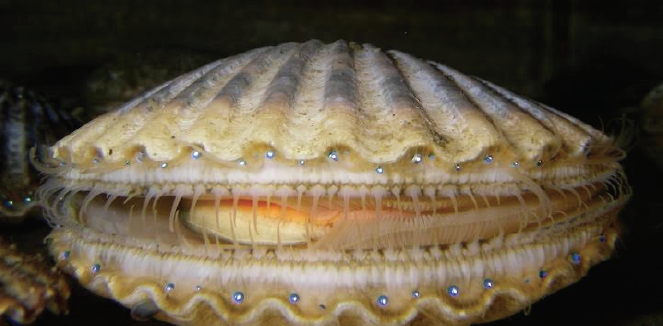 RESTRICTIONS on scallop fishing in Cardigan Bay were originally placed in 2008-9, following an influx of boats from around the UK.
RESTRICTIONS on scallop fishing in Cardigan Bay were originally placed in 2008-9, following an influx of boats from around the UK.
At present, one area of the bay, known as the Kaiser Box after scientist Michel Kaiser, is open to scallop dredging on a seasonal basis. However, as has been pointed out, beam trawling is still permitted in the bay outside the three mile limit.
A study commissioned by the Welsh Government to assess whether a sustainable scallop fishery in Cardigan Bay was feasible was completed in 2015. The report found that most of the area outside of the three mile fishing limit was relatively shallow and the seabed composed of a mixture of mixed sediment (gravels and sands) overlaid with highly mobile sand waves.
‘As a result of high levels of wave erosion, the seabed is dominated by opportunistic species such as small bivalves and worms and ephemeral surface dwellers like crabs and starfishes’, a summary of the report stated.
It was noted that the seabed in these areas was generally resilient to the effects of dredging, and that recovery was swift. In most cases, there were no marks left by dredging evident a year after the area was fished.
The findings were: “Seabed animal communities living in Cardigan Bay mostly recovered within four months of the fishing disturbance, particularly in areas fished less than four times. This recovery period coincided with summer recruitment and growth of seabed animals. The current management practice of a seasonal closure over the summer would appear to facilitate recovery of the biological components on the seabed.
“The seabed in deeper water offshore seems to be partly reconstructed by natural processes within four months of fishing disturbance and certainly 10 months later and would appear to be able to withstand fishing intensities up to 6.2 times complete coverage by scallop dredging. Some areas closer inshore would appear to take longer for the seabed to be reformed by natural processes and may require a full year for this to occur (with fishing intensities of 3.8 times swept per year).”
The presence of cobble reefs and bottlenose dolphins were the main factors behind the creation of the Cardigan Bay Special Area of Conservation. Most of the cobble reefs in the bay are within the three mile limit, and there has been no suggestion that the entire bay will be permanently opened to scallop dredging.
In terms of potential harm to the dolphin population of the bay, the picture is far less clear-cut. In a snappily-titled opinion piece for The Guardian newspaper ‘The Dolphin Killers of Cardigan Bay’, environmental activist George Monbiot claimed that ‘when bottlenose dolphin calves are young, their mothers rely for much of their food on slow or sedentary animals on the seafloor, as they cannot travel fast or far at this time. Sustaining a healthy dolphin population, in other words, means sustaining a healthy seabed’.
It is also worth noting that the bottlenose dolphin population in Cardigan Bay declined between 2008-14. However, the Director of Sea Watch, Dr Peter Evans, said it was difficult to be sure that the two were related: “It could be due to natural changes in food availability or to the increasing evidence of disturbance related to the rise in recreational activities in the area. Or it could be a combination of all these. At present we don’t know,” he added.
Dr Evans went on to suggest that he believed dolphins and scallop dredging could co-exist, even within an SAC, and also recognised that restricting the scallop fishery to a limited area, as is currently the case, was unsustainable, ‘so either a larger area needs to be included, or the activity (which means its profits) should be limited’.
“A balance should therefore be struck. In this context, authorities should bear in mind that the overall annual income from dolphin-watching (direct through boat trips and indirect through purchase of food/meals, gifts and accommodation) is estimated to well exceed £3.5 million, and to involve 50,000+ visitors to West Wales,” he concluded.
The Welsh Government proposals which were put up for public consultation included restricting fishing activity through quotas (if necessary) temporal restrictions such as those which are currently in place, and rotational open areas, which would mean that the seabed would be given additional time to recover if needed.
However, Mid and West AM Simon Thomas is among a number of people who have accused the Welsh Government of turning their backs on ‘concerned constituents’, as well as putting the future of vulnerable wildlife at risk.
“I’ve met with Petition organisers and continually kept my constituents updated as I asked the Cabinet Secretary for the Environment and Rural Affairs, Lesley Griffiths, to rethink the Welsh Government’s position and support the sustainability of the sensitive Ceredigion marine environment,” he added. A petition calling on the Welsh Government to change its plans currently has more than 30,000 signatures.
However, like his third Assembly predecessor in the role, Elin Jones AM, Mr Thomas wished to see a sustainable scallop fishery in Cardigan Bay: “First we have to ensure the current habitats have recovered enough to support such dredging. The decision to allow dredging when we don’t fully understand the impact on those areas that are supposed to be under conservation is concerning,” he remarked, before questioning how the WG would police the scallop fishery.
While it is unclear at present exactly what changes the Welsh Government would bring to policing the fishery, the current ‘suckfish’ dual tracker system used to enforce scallop dredging in the bay at present should still be effective if new areas were opened up.
The main deterrent to fishing outside permitted areas, or failing to comply with government imposed terms and conditions would be, as is the case today, heavy financial penalties. The skipper of a small scallop dredger was recently fined £13,000 for fishing outside the Kaiser Box, and was caught doing so as a result of tracker data. The skipper of a Cornish dredger was ordered to pay £50,000 in fines and costs in 2014, and it is worth noting that the Welsh Government pushed for a much stricter penalty at the time.
The question of allowing the habitat to recover is a far more complex issue, largely because confusion appears to exist over the point it is to be allowed to recover to. Cardigan Bay has been fished using a wide mixture of fishing techniques since time immemorial, and it is reasonable to assume that a large proportion of it has been bottom-trawled at some point over the last 50-100 years.
The view espoused by George Monbiot and Professor Callum Roberts, who contributed to The Guardian article above, was directly referred to by researchers from Bangor University who said: “Clearly we know that Robert’s statement is rather simplistic, as does any first year student of ecology who has studied succession in natural systems.”
While the findings of the Bangor University study have been openly queried, this remains the most comprehensive study of its kind ever carried out in the UK, and peer reviews described the work as ‘of high merit’ and sufficient to inform Welsh Government policy’.

















Add Comment